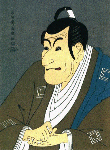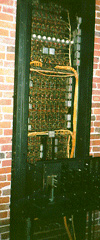
No, it's possible... really!
But it is a very difficult topic. I'll be the first to admit that I'm not terribly qualified to be an expert on this, but I've managed to succeed on my own systems, this means you can too!
Below are some general notes of the issues facing the English-based computer user in trying to get up and running with Japanese on their system. Following that is what I've managed to pull off on my own systems, and finally a list of truly valuable and informative links that explain these issues much better.
The first thing you have to come to terms with is that while most Americans use ASCII encoding schemes, it is not the only encoding scheme in the world. Granted, Americans have very little trouble viewing documents created in most European countries, but when the writing system moves too far away from the Roman alphabet, troubles with compatability arise.
In Japan, there are three common encoding types:
 JIS
JIS
Japanese Industrial Standard
This is the most common encoding type used in Japan, pretty much it's the Japanese answer to the American National Standards Institute (ANSI) coding.
Shift-JIS
This is the Microsoft version of JIS used on PC boxes. On occaision I've had trouble reading Shift-JIS encoded documents on my Mac, but fortunetly I have backup programs on my PS/2.
EUC
Extended Unix Code
This is similar to JIS, but without escape codes. It's used more as a standard for world languages. I don't see a lot of EUC encoded documents, maybe UNIX users do. I'd have to ask around.
Why not use ASCII? Well for one thing, ASCII only has 256 characters in its expanded set; Japanese has, aside from the English alphabet, over 30 hiragana and katakana characters, and over 2,000 commonly used kanji. This makes for quite a challenge in encoding for the computer and creating a standard. JIS makes use of escape character sequences to code each and every single character, EUC does somthing similar. The problem is that it's not standard equipment provided on English-based systems that use ASCII.
What you need is a front-end processor style of program that can store character information, call them up, display, save and print. Unless your system is specifically designed for this, adapting these needs to a English-based computer is pretty challenging.
That's not to say that it's impossible.
 On my PS/2 using Windows 3.1, I very easily run Jim Breen's Japanese Word Processor. This is a free download! Not just the program, but a host of dictionaries specially aimed for specific users. It's the massive EDICT Project, and we all appreciate the work being put into it by Mr. Breen and his associates.
On my PS/2 using Windows 3.1, I very easily run Jim Breen's Japanese Word Processor. This is a free download! Not just the program, but a host of dictionaries specially aimed for specific users. It's the massive EDICT Project, and we all appreciate the work being put into it by Mr. Breen and his associates.
On my pre-Windows machines, I've have running a program called NJStar. This was also a free download from a commercial company, but they have Windows-based versions of their products for sale.
The Macintosh was a whole other story. For that I was hard-pressed to find anything that could handle japanese word processing without costing a bit of money. Add to that the fact that my Macs are pretty old, it was difficult to find system software old enough for my machine.
Lucky for me, I met a gentleman living in Japan who took pity on my plight and sent my an old copy of Japanese Language Kit for the Macintosh and KanjiTalk 7.0. This worked great! I can now read Japanese easily on my Mac. It was difficult to set up, and it took a while to get used to the japanese input functions (kotoeri), but not impossible. Sad to say for you Mac users out there, expect to search a lot for programs that Windows users find more easily. To find information on Japanese Language Kit, visit Apple's web site. KanjiTalk is not available outside of Japan.
In all cases, I can also print out Japanese text in bitmap form. Postscript fonts for the Mac are available as well.
To be honest, there are many more people out on the Net more qualified to talk about Japanese on the computer. Below are some links to get you started. They are well worth exploring. Everyone's needs are different, but everyone is pretty much covered. ^_^
Before you move on to the links however, I'd like to make a request. If you have any good, organized information on Japanese computing using DEC equipment, or pre-Windows environments, let me know! For those of you who don't know already, I collect old computers (for more info on this go to Tumbleweed's Computer Shack. I'm looking for old software, old computer systems or anything else fairly old and "obsolete" that uses Japanese. If you have any information or offers, write to tumble@ids.net. Arigatou! ^_^
 Now... on to the links!
Now... on to the links!
Well that's about it for now. Actually, there a probably many other informative links out there to try. You can find most of them by starting at the ones above. There's a fairly large community of students, teachers, enthusiasts and professionals out there all seeking to bridge the language gap through computers.
I hope this page has helped a few of you out there. if it has, or if you have any questions, please write to me at tumble@ids.net. I'd be happy to talk with you more on this subject.
Thanks again for visiting this page. Here are links to my other pages for your viewing and information pleasure. Click below! ^_^

Tumbleweed's Corner
Tumbleweed's Computer Shack
Tumbleweed's Anime and Manga Page
Tumbleweed's Picture Albums
Tumbleweed's Guide to Learning Japanese
Comics Page
Links Index
Tumbleweed's Shack / tumble@ids.net / last rev. July 3, 1998, 9:15 p.m.
Oh yeah! To send mail, comments, vague threats and whatnot... do so! at John Teehan at tumble@ids.net!